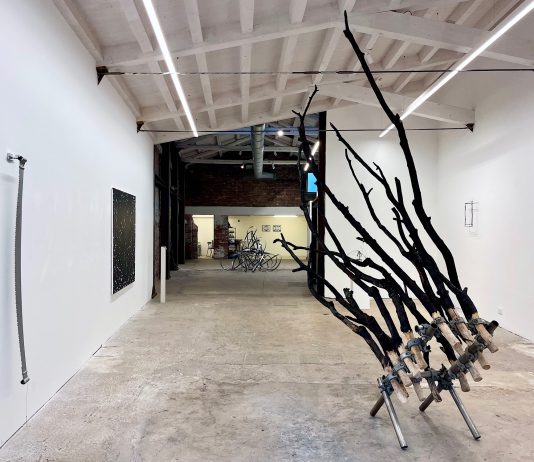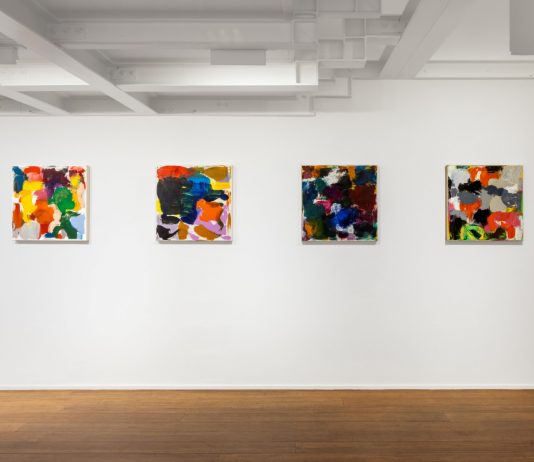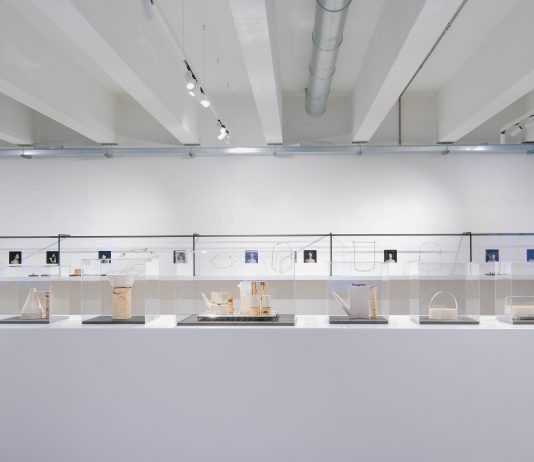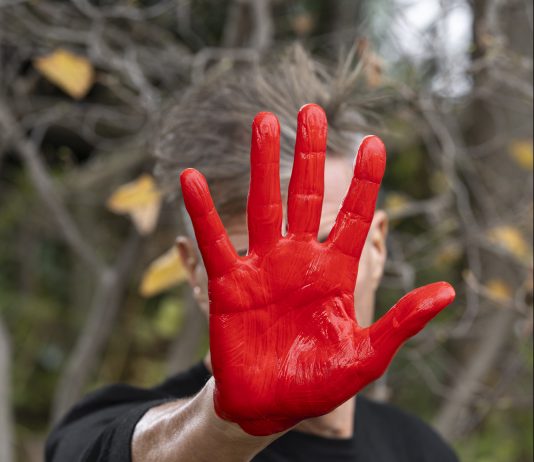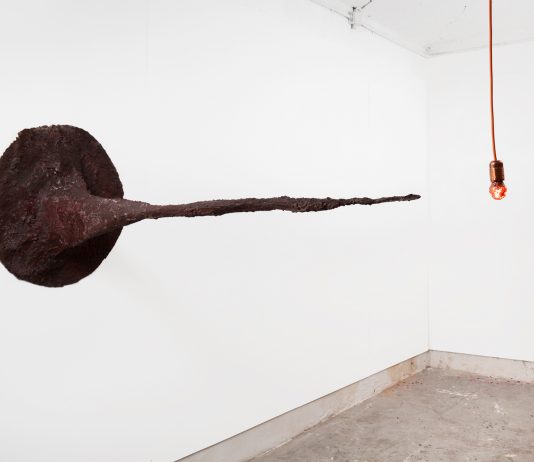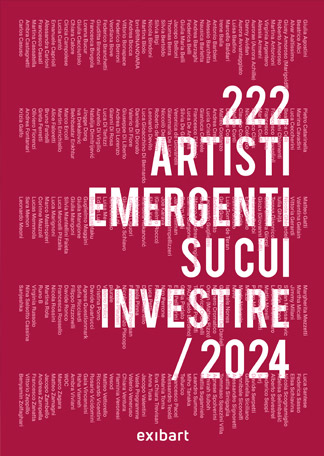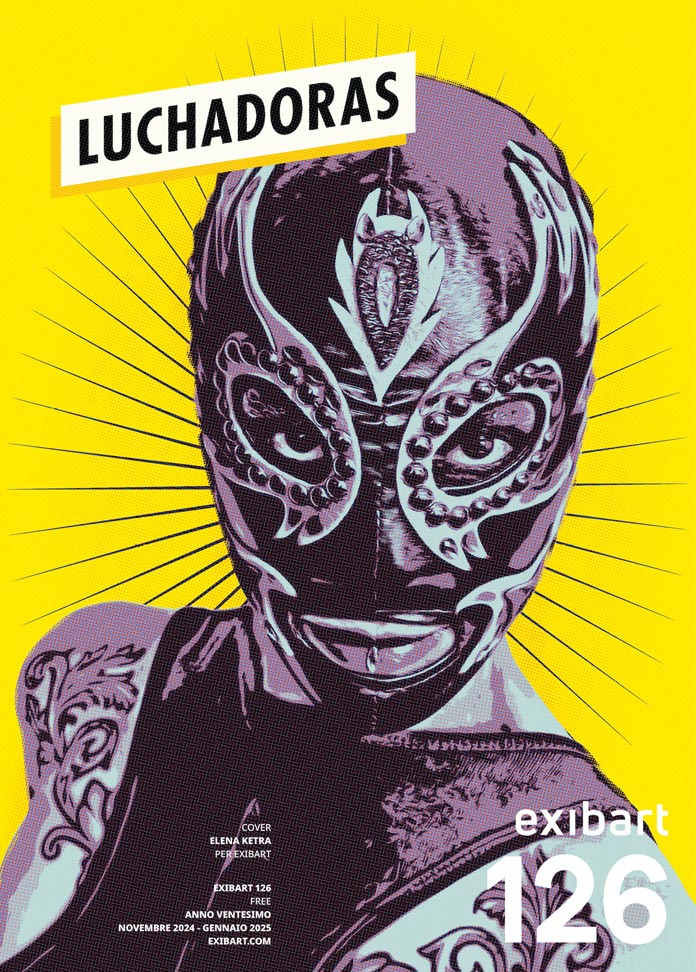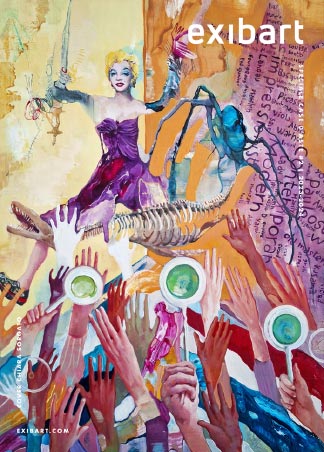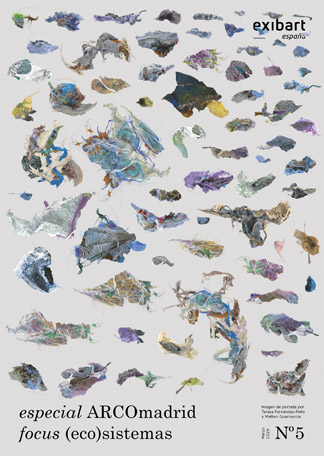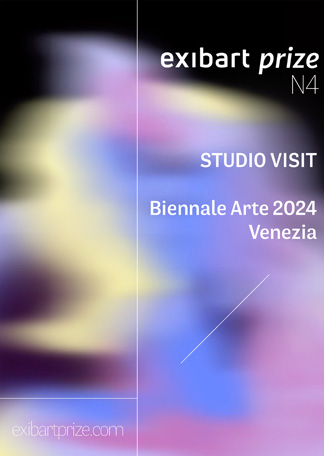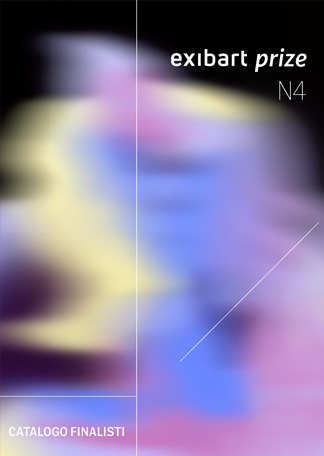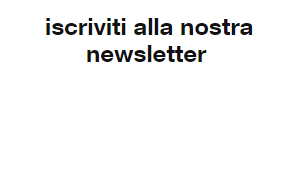-
- container colonna1
- Categorie
- #iorestoacasa
- Agenda
- Archeologia
- Architettura
- Arte antica
- Arte contemporanea
- Arte moderna
- Arti performative
- Attualità
- Bandi e concorsi
- Beni culturali
- Cinema
- Contest
- Danza
- Design
- Diritto
- Eventi
- Fiere e manifestazioni
- Film e serie tv
- Formazione
- Fotografia
- Libri ed editoria
- Mercato
- MIC Ministero della Cultura
- Moda
- Musei
- Musica
- Opening
- Personaggi
- Politica e opinioni
- Street Art
- Teatro
- Viaggi
- Categorie
- container colonna2
- container colonna1
A proposito di zen, post-verità e realtà: quattro chiacchiere con Dumb Type
Arte contemporanea
Commissionato e organizzato da The Japan Foundation, il padiglione Giappone ai Giardini della Biennale di Venezia ha ospitato un’installazione del collettivo giapponese Dumb Type (Shiro Takatani, Ryuichi Sakamoto, Ken Furudate, Satoshi Hama, Ryo Shiraki, Marihiko Hara, Hiromasa Tomari, Takuya Minami, Yoko Takatani) dal titolo 2022. Forse troppo sbrigativamente liquidata dai visitatori, meno eclatante e più introspettiva (e come potrebbe essere altrimenti!) rispetto ad altre proposte nazionali, abbiamo voluto saperne di più, anche perché il tema è la post-verità, che negli ultimi tempi è diventata una chiave fondamentale, e insidiosa, di interpretazione della realtà. Due membri del gruppo, Takatani Yoko e Shiro, quest’ultimo anche tra i fondatori di Dumb Type nel 1984, hanno risposto molto gentilmente alle nostre domande nel corso di questa calda, calda estate.
Quando e come è nata l’idea per il progetto? La pandemia e il periodo di isolamento hanno avuto una parte nella concezione dell’installazione 2022?
Poiché creiamo lavori diversi membri insieme, partiamo sempre dalla discussione l’uno delle idee dell’altro. Durante il processo, abbiamo trovato il testo di un libro scolastico di Geografia degli anni cinquanta dell’800, First Lessons in Geography. Ci sono delle domande semplici, ma universali come «Che cos’è la Terra?», «Qual è la forma della Terra?», «Quanti continenti ci sono?», «Su quale continente viviamo?», «Quante nazioni ci sono?», «Come sono divise?», etc… Come ognuno ha potuto sperimentare, la situazione pandemica del Covid ci ha portato sentimenti di ansia e un senso di irrealtà. Abbiamo passato un periodo difficile senza poter incontrare altra gente, ma dall’altro lato, abbiamo potuto comunicare attraverso Internet con persone che vivono lontano. Stavamo pensando al modo di comunicare che è stato trasformato dall’evoluzione e dalla crescita di Internet e dei social Media, e anche dalla pandemia globale. Allo stesso tempo, pensiamo allo stesso termine «globale» – il mondo in cui viviamo. Abbiamo pensato che il testo (quelle domande) del libro scolastico di geografia sarebbe diventato la chiave per iniziare a pensarci.
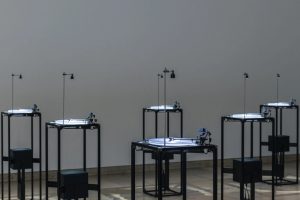
L’interno del Padiglione Giappone evoca le stesse proporzioni di un chashitsu, la stanza della cerimonia del tè: come ha influenzato la vostra installazione?
Fondamentalmente, volevamo creare l’installazione utilizzando al meglio l’architettura del Padiglione Giappone, per quanto possibile. Quindi, se lo hai sentito come una stanza della cerimonia del tè, può anche derivare dallo spirito di Takamasa Yoshizaka, l’architetto del Padiglione Giappone. In realtà, abbiamo avuto un’esperienza significativa in una stanza della cerimonia del tè nel Tempio di Daitokuji a Kyoto. C’era anche Ryuichi Sakamoto. Mentre eravamo nella stanza della cerimonia del té iniziò a piovere fortissimo. Siedevamo lì, ascoltando da dentro la stanza il suono della pioggia, potevamo sentire meglio il mondo esterno quando ne eravamo separati da una singola porta di carta, percependo il suono e la luce all’interno della stanza, piuttosto che sentendo direttamente cosa c’era là fuori. Per l’installazione alla Biennale, volevamo creare una sensazione della presenza degli altri dentro un mondo virtuale nella nostra era divisa, insieme alla percezione del mondo esterno alla stanza del tè che tu puoi sentire attraverso il suono.
Quanto sono importanti la cultura e le tradizioni giapponesi antiche anche nell’arte contemporanea?
Non siamo sicuri se la cultura e le tradizioni giapponesi siano collegate con l’arte contemporanea, ma stiamo vivendo sulle linee della storia che è passata. Volevamo solo creare qualcosa con niente di fisico. Ci sono solo suono, voce e luce. Se spegni l’elettricità, sparisce tutto. Rimangono solo il silenzio e la luce naturale.
Uno dei punti chiave dell’opera è il concetto di post-verità, da cui la nostra epoca sembra essere caratterizzata: cos’è la post-verità vista da un punto di vista zen?
La disinformazione (le fake news) e bias vari esistono da molto tempo. Ma ora, questi fenomeni si sono mossi a un livello completamente differente, per la crescente popolarità dei social media. I fari che indicano la direzione dove andare sono ora innumerevoli e invalidi, e stanno sull’orlo di un mondo dove non riesci a trovare il centro. Ci si chiede di vivere mentre stiamo in equilibrio sul limite ambiguo. Il centro è Vuoto = è il buco ricoperto di vetro al centro della sala espositiva.
-300x200.jpg)
Come è nata la collaborazione con David Sylvian? Gli avete chiesto voi di partecipare o ve lo ha proposto lui quando ha saputo del progetto 2022?
Ryuichi è un caro amico di David. Quando abbiamo deciso di usare il testo del libro di testo di geografia, Ryuichi ha pensato che sarebbe stato buono chiedere a David di leggere il testo. David ha risposto subito alla sua richiesta e ha gentilmente acconsentito. La sua voce è bellissima, ci piace molto. I testi sono proiettati da lasers sui muri circostanti, ma è anche bello sentirli leggere dalle voci. Le voci toccano i visitatori direttamente.
Anche Haus der Kunst a Monaco sta attualmente ospitando una vostra mostra (la mostra è finita l’11 settembre. NdR): esiste una connessione con l’installazione di Venezia?
Playback, uno dei lavori esposti adesso a Haus der Kunst, è composto da 16 giradischi. Dumb Type ha dato il benvenuto a Ryuichi Sakamoto come nuovo membro, e Ryuichi ha disposto di realizzare 16 dischi per l’installazione. La sua idea era chiedere a 16 amici di registrare i suoni ambientali del luogo in cui vivono. Quei field recording fatti da 16 persone in giro per il mondo, fanno parte anche dell’installazione alla Biennale Venezia.
Pensate che gli abitanti del pianeta Terra, in questo momento storico, stanno perdendo il contatto con la realtà e con la natura?
Da quando è scoppiata l’epidemia di Covid, ancora passiamo la maggior parte del tempo a casa o nel nostro studio privato. A volte abbiamo una sensazione di irrealtà. Ma a noi interessa solo la realtà, specialmente la natura. Pensiamo che sia fondamentale.
TESTO ORIGINALE
When was the idea for the project born and how? Did the recent pandemic and isolation period play a part in conceiving the 2022 installation?
Since we are creating works with multiple members, always we start by discussing each other’s ideas. During the process, we found the text of 1850s geography textbook (“First Lessons In Geography”). There are simple yet universal questions such as “What is the Earth?”, ”What is the shape of the Earth?”, “How many Continents are there?”, ”On which Continent do we live?”, “How many Countries are there?”, “How are they divided?”, etc…As everyone has experienced, the Covid pandemic situation has brought us feelings of anxiety and sense of unreal. We spent difficult time without being able to meet people, but on the other hand, we can communicate with people living far away through the Internet. We were thinking about the way of communication which was transformed by the evolution and growth of the internet and social media, and also by the global pandemic. Similarly, we think about “global” itself – the world where we live. We thought that the text (those questions) of the geography textbook would become the key to start to think about.
The interior of the Japan Pavilion evokes the same proportions as a chashitsu, the tea ceremony room: how did it influence your installation?
Basically, we intended to create our installation by making the best use of the architecture of the Japan Pavilion as much as possible. So, if you felt it as a tea ceremony room, it may also come from the spilit of Takamasa Yoshizaka, the architect of the Japan Pavilion. Actually, we had a significant experience in a tea ceremony room at Daitokuji temple in Kyoto. Ryuichi Sakamoto were there too. When we were in a tea ceremony room, suddenly it started to rain heavily. We sat there, listening to the sound of the rain from inside the room, we could experience the outer world better when we were separated by a single paper door, feeling the sound and light inside of the room, rather than experiencing what’s out there directly. For the installation at the Biennale, we wanted to create a feeling of the presence of others within a virtual world in our divided era, along with the sensation of the world outside of the tea room that you can sense through sound.
How important is ancient Japanese culture and tradition even in contemporary art?
We are not sure whether ancient Japanese culture and tradition are related to contemporary art, but we are living on the lines of history that has passed. We just wanted to create something with nothing physically. There are only sound, voice and light. If you turn off the electricity, everything disappears. Only silence and natural light remain.
One of the key points of the exhibition is the concept of post-truth, from which our age seems to be characterized: what is post-truth seen from a Zen point of view?
Misinformation (fake news) and various biases have existed for a long time. But now, such these phenomena have moved to a completely different stage by the growing popularity of social media. The lighthouses that determine the direction to go are now innumerable and invalid, standing on the edge of a world where you can’t find the center. We are required to live while balancing on the ambiguous edge. The center is Void = It’s the hole covered with glass in the center of the exhibition room.
How did the collaboration with David Sylvian come about? Did you ask him to participate or did he offer himself when he found out about the project 2022?
Ryuichi is a very good friend of David. When we decided to use the text of the geography textbook, Ryuichi thought that it must be good to ask David to read the text. David responded his request right away, and kindly agreed. His voice is awesome, we love so much. The texts are projected onto the surrounding walls by lasers, but it is also great to hear in reading voices. The voices touch the visitors directly.
Haus der Kunst in Munich is also hosting an exhibition of yours, currently: is there a connection between the two exhibitions?
Playback, one of the artworks exhibited at Haus der Kunst now, is composed by 16-turntable units. Dumb Type welcomed Ryuichi Sakamoto as a new member, and Ryuichi directed to make the 16 records for the installation. His idea was to ask his 16 friends to record the environmental sounds of their living place. Those field recordings from around the world by 16 people are also included in the installaiton at Venice Biennale.
Do you think that we all inhabitants of planet Earth, at this historical moment, are losing touch with reality? And with nature?
Since the Covid outbreak, still we spend most of time at home or in our private studio. Sometimes we feel unreal. But we are only interested in reality, especially nature. We think it’s fundamental.





-1068x712.jpg)
